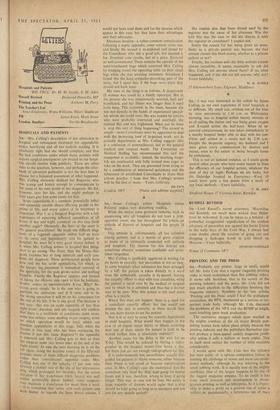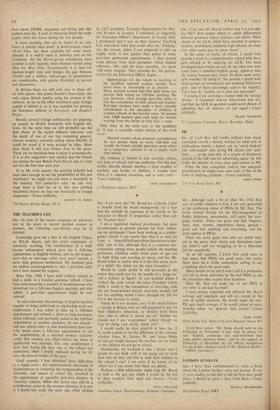PRINTING AND THE PRESS
SIR,---Probably any printer, large or small, would tell Mr. John Cole that a regular magazine printing order is more' economical than five jobbing orders. It seems odd, therefore, that in his survey of the printing industry and the press. Mr. Cole- did not pay much attention to the difficulties besetting the magazine industry. Nowhere in his two articles 'Printing and the Press' could I find the publishers' association, the PPA. mentioned as a serious or im- portant trade body, although Mr. Cole discussed the problems of the NPA and the BFMP at length, even touching upon book production.
The successive mergers which have resulted in the mighty combine of the six major British pub- lishing houses have taken place simply because the printing industry and the publishers themselves can- not produce a mass-appeal weekly magazine profit- ably unless it sells a million or more copies. This in itself must restrict the number of titles available considerably.
I would agree with Mr. Cole that the industry has been guilty of 'a serious competitive failure in meeting the challenge of newer and more unconven- tional methods,' although he was referring to the small jobbing work. It is equally true of the mighty combines. One of the largest happens to be one of the biggest magazine empires. To its credit it has done much research and development in photo- gravure printing, as well as letterpress. As it is impos- sible to make a profit on a gravure run of under a million or, paradoxically, a letterpress run of mwe than about 250,000, magazines not fitting into this pattern must die. A trail of obituaries litters the trade papers from this house during the last decade.
Is there anything that can be done? if so, why hasn't it already been tried? A third process, rotary
off-set litho, has been available for some years. Already it is widely used in America and on the Continent. All the Mirror•-group subsidiaries have avoided it until recently, when Newnes started using litho for Men Only. Economically it is best for medium-length runs and bridges the gap between 250,000 and a million. Advantages in presentation are considerable, with greater flexibility in lay-out and illustration.
In Britain there arc still only two or three off- set litho plants. One prints Purnell's Knowledge, the only major British weekly using the process at the moment. As far as the other machinery goes, foreign capital is behind it, as it was installed for printing the European editions ,of Newsweek and Reader's Digest.
Shortly, several foreign publications are planning an assault on British bookstalls with English edi- tions. At the same time we will probably see the first effects of the recent Odhams take-over and the death of one of our last remaining general- interest weeklies, currently selling about 800,000. It could be saved if it were printed by litho. More than likely it will join Picture Post in the grave. There are no machines here to print it economically. It is at this magazine's very market that the French are aiming the new British Paris-Match, due to come out for the first time next year.
If, as Mr. Cole asserts, 'the printing industry had been alert enough to see the possibilities of the new machinery,' we might not now have a monopoly in the industry. For posterity's sake, we can only hope there is time for us to buy new printing machinery before we lose our bookstalls to foreign magazines.—Yours faithfully,
ANTHONY M. PERRY















































 Previous page
Previous page